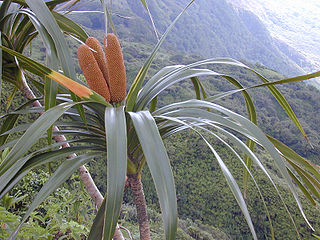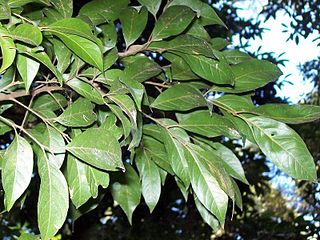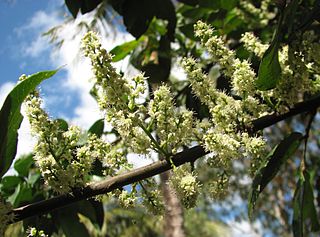
Freycinetia is one of the five extant genera in the flowering plant family Pandanaceae. The genus comprises approximately 180–200 species, most of them climbers.

Jagera is a genus of 4 species of forest trees known to science, constituting part of the plant family Sapindaceae.

Orites is a genus of 9 known species, 7 endemic to Australia and 2 in South America; 1 in the Chilean Andes and 1 in Bolivia.

Xanthostemon is a genus of trees and shrubs, constituting part of the myrtle plant family Myrtaceae. This genus was first described in 1857 by German–Australian botanist Ferdinand von Mueller. According to different official sources between 46 and 51 species are known to science. They grow naturally in New Caledonia, Australia, the Solomon Islands and Malesia, including the Philippines, New Guinea and Indonesia. The genera Pleurocalyptus and Purpureostemon from New Caledonia are morphologically close to Xanthostemon.

Jagera pseudorhus, commonly named foambark, is a species of rainforest trees, in the northern half of eastern Australia and in New Guinea, constituting part of the flowering plant family Sapindaceae. Named for the saponin foam that forms on the bark after heavy rain.

Trochocarpa is a genus of shrubs or small trees, of the plant family Ericaceae. They occur naturally through coastal and montane eastern Australian rainforests and mountain shrublands and in New Guinea, Borneo and Sulawesi (Malesia).

Sarcopteryx is a genus of about 12 rainforest tree species known to science, of the plant family Sapindaceae. They occur in Australia, New Guinea and the Moluccas.
Ganophyllum falcatum, commonly known as the scaly ash, is an evergreen rainforest tree. It grows up to 32 metres high and has rough, flaky bark. The species was described by German-Dutch botanist Carl Ludwig Blume in 1851 based on plant material collected from the coast of New Guinea.It is native to Africa, the Andaman Islands, Asia, Malesia and northern Australia. The ovoid fruits are consumed by fruit pigeons and cassowaries.
Hollandaea is a small genus of plants in the family Proteaceae containing four species of Australian rainforest trees. All four species are endemic to restricted areas of the Wet Tropics of northeast Queensland.

Carnarvonia is a flowering plant genus of a single species, commonly named red oak or red silky oak and constituting part of the plant family Proteaceae. The single species named Carnarvonia araliifolia grows to large trees of 30 m (100 ft) or more. They grow naturally only (endemic) to the Wet Tropics rainforests region of north-eastern Queensland, Australia. The species has two described varieties, C. araliifolia var. araliifolia and C. araliifolia var. montana, and the common names are used for both.

Mischarytera is a genus of rainforest trees, constituting part of the plant family Sapindaceae. Four species are known to science as of December 2013, found growing naturally in eastern Queensland, Australia, and in New Guinea. Formerly until 1995, they had names within the genus Arytera, subgenus Mischarytera.
Rhysotoechia is a genus of tropical rainforest trees, constituting part of the plant family Sapindaceae.
Synima is a genus of tropical rainforest trees, constituting part of the plant family Sapindaceae.

Guioa acutifolia is an evergreen tree from New Guinea and coastal areas of eastern Queensland in Australia. Common names include glossy tamarind, northern guioa and sharp-leaf guioa. It grows up to 20 metres high and has smooth, grey bark on its trunk which may be up to 15 cm wide. The sweetly scented flowers are produced between August and October in the species' native range Flowers and fruits often appear on immature trees.

Toechima daemelianum, commonly known as cape tamarind, is an evergreen tree from north-east Queensland in Australia. It grows up to 13 metres high and a trunk which may be up to 20 cm wide.
Lepidopetalum is a genus of six species of trees known to science, constituting part of the plant family Sapindaceae.
Cnesmocarpon is a genus of 4 species of rainforest trees known to science, constituting part of the plant family Sapindaceae.
Hollandaea diabolica is a species of Australian rainforest tree, constituting part of the plant family Proteaceae. It is endemic to restricted areas of the rainforests of the Wet Tropics region of northeastern Queensland.
Hollandaea porphyrocarpa is a species of small Australian rainforest tree in the plant family Proteaceae. It is endemic to restricted areas of the rainforests of the Wet Tropics region of northeastern Queensland.
Peripentadenia is a genus of two species of large trees from the family Elaeocarpaceae endemic to the rainforests of northeastern Queensland, Australia. Sometimes they have the common name quandong.










